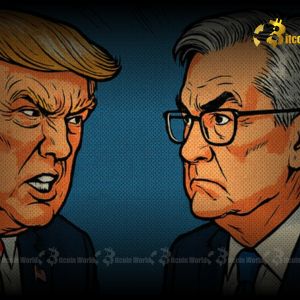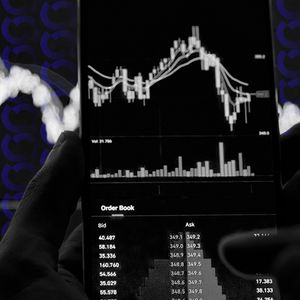BitcoinWorld Jerome Powell’s Unwavering Resolve: Navigating Donald Trump’s Attacks on the Federal Reserve In the dynamic world of global finance and, by extension, the often-volatile cryptocurrency markets, the words and actions of central bankers hold immense weight. When the head of the world’s most influential central bank, the Federal Reserve, speaks, everyone listens. Recently, Jerome Powell, the esteemed Chairman of the Federal Reserve, found himself once again in the crosshairs of direct criticism from former U.S. President Donald Trump. His response? A concise yet powerful affirmation: “I’m very focused on doing my job.” This seemingly simple statement carries profound implications for the independence of the Federal Reserve, the stability of the US Economy , and the broader financial landscape that indirectly influences crypto valuations. Understanding the Core Conflict: Jerome Powell vs. Donald Trump The tension between Jerome Powell and Donald Trump is not new. It’s a recurring theme that underscores a fundamental debate about the role and autonomy of central banks. During his presidency, Trump frequently and vociferously criticized Powell and the Federal Reserve’s interest rate policies, particularly when the Fed raised rates. Trump often argued that these rate hikes were hindering economic growth, strengthening the dollar too much, and undermining his administration’s efforts to boost the economy. His criticisms were unprecedented for a U.S. president, openly challenging the traditional independence of the central bank. Powell, throughout these periods of intense political pressure, consistently maintained a stance of non-partisanship and commitment to the Fed’s dual mandate: achieving maximum employment and maintaining price stability. His recent statement, reiterated in the face of renewed attacks, serves as a powerful reminder of this unwavering dedication. It signals that the institution’s decisions will be guided by economic data and its statutory objectives, rather than political expediency or short-term electoral cycles. Why is the Federal Reserve’s Independence So Crucial? The concept of an independent central bank is a cornerstone of modern economic governance in many developed nations. But why is this autonomy so highly valued, and why does political interference raise so many alarms? The Federal Reserve, established in 1913, was designed to operate free from direct political influence precisely to avoid the pitfalls of short-term political thinking. Long-Term Stability: An independent Fed can make tough, unpopular decisions (like raising interest rates during an economic boom to prevent inflation) that are necessary for long-term economic health, without fear of immediate political backlash or losing elections. Credibility and Predictability: When markets trust that the Fed’s decisions are based on economic fundamentals rather than political whims, it enhances the credibility of monetary policy. This predictability helps businesses and consumers plan for the future, fostering investment and stability. Avoiding Inflationary Pressures: Historically, when central banks have been subjected to political pressure to print money or keep interest rates artificially low to stimulate growth before elections, it often leads to rampant inflation, eroding purchasing power and destabilizing the economy. Protecting the Financial System: An independent Fed can act decisively during financial crises, implementing measures to stabilize markets and prevent systemic collapse, even if those measures are politically unpopular in the short term. The attacks from Donald Trump , while vocal, have so far failed to compromise the Fed’s operational independence, largely due to Powell’s steadfastness and the institutional strength of the Federal Reserve itself. This resilience is vital for maintaining investor confidence, both domestically and internationally. The Intricacies of Monetary Policy and Its Reach At the heart of the Federal Reserve’s responsibilities lies Monetary Policy . This refers to the actions undertaken by a central bank to influence the availability and cost of money and credit to help promote national economic goals. The Fed has several key tools at its disposal: The Federal Funds Rate: This is the target rate for overnight lending between banks. By adjusting this rate, the Fed influences interest rates throughout the economy, impacting everything from mortgage rates to business loans. Quantitative Easing (QE) and Quantitative Tightening (QT): These involve the buying or selling of government securities and other assets in the open market. QE injects liquidity into the financial system, while QT removes it. These actions directly affect long-term interest rates and the overall money supply. Reserve Requirements: The amount of funds that banks must hold in reserve against deposits. While less frequently used now, it’s a powerful tool to influence the amount of money banks have available to lend. Discount Rate: The interest rate at which commercial banks can borrow money directly from the Federal Reserve. When Jerome Powell states he is “focused on doing his job,” it means he is committed to using these tools to navigate complex economic conditions – balancing the fight against inflation with the goal of sustaining maximum employment. This is a delicate act, requiring careful analysis of economic data, foresight, and a willingness to make difficult choices that might not always be popular but are deemed necessary for the nation’s financial health. How Does This Impact the US Economy and Beyond? The stability and direction of the US Economy are profoundly influenced by the Federal Reserve’s actions. When interest rates are low, borrowing becomes cheaper, encouraging investment, spending, and job creation. Conversely, when rates are high, borrowing becomes more expensive, which can cool down an overheated economy and combat inflation. The ripple effects of these decisions are global, given the U.S. dollar’s role as the world’s primary reserve currency. For the cryptocurrency market, the connection is often indirect but significant. Higher interest rates in the traditional financial system can make less risky assets, like government bonds, more attractive, potentially drawing capital away from more speculative assets like cryptocurrencies. Conversely, a looser monetary policy, characterized by lower rates and increased liquidity, can make riskier assets more appealing, as investors seek higher returns. The perception of economic stability, heavily influenced by the Fed’s actions, also plays a role in investor sentiment towards volatile assets like Bitcoin and Ethereum. Consider the recent period of high inflation. The Federal Reserve aggressively raised interest rates to bring prices under control. While this led to concerns about a potential recession, it demonstrated Powell’s commitment to price stability, even in the face of political and public pressure to ease up. This commitment is what gives the Fed its credibility and allows it to effectively steer the economy through turbulent waters. Navigating the Challenges: What Does Steadfastness Mean for the Future? The challenges facing the Federal Reserve are multifaceted. Beyond political critiques, they include managing persistent inflation, navigating geopolitical uncertainties, responding to rapid technological changes, and addressing issues like financial stability in an increasingly interconnected global economy. Jerome Powell ‘s unwavering focus on his job signifies a dedication to evidence-based decision-making, rather than succumbing to external pressures. This steadfast approach suggests several key implications for the future: Data-Driven Decisions: The Fed will likely continue to prioritize economic data (inflation figures, employment reports, GDP growth) in its policy deliberations, rather than political rhetoric. Independence Reinforced: Powell’s public stance reinforces the institutional independence of the Federal Reserve, setting a precedent for future chairs and potentially deterring future attempts at direct political interference. Market Confidence: A perceived independent and competent central bank generally fosters greater confidence in financial markets, reducing uncertainty and encouraging long-term investment. Potential for Volatility: While independence is positive, it also means the Fed will make decisions that might be unpopular in the short term if they are deemed necessary for long-term stability. This could lead to periods of market volatility as participants adjust to policy shifts. Ultimately, Powell’s statement is a testament to the principles that underpin effective central banking. It’s a declaration that the institution’s primary allegiance is to its dual mandate and the economic well-being of the nation, not to any political agenda. Concluding Thoughts: The Enduring Importance of Central Bank Autonomy The ongoing narrative of Donald Trump ‘s criticisms against Jerome Powell and the Federal Reserve highlights a critical aspect of modern governance: the delicate balance between democratic accountability and institutional independence. Powell’s calm and resolute response, emphasizing his dedication to his professional duties, underscores the vital importance of an autonomous central bank for a stable and predictable financial environment. In a world where economic certainty is increasingly prized, the Fed’s ability to make decisions free from political coercion is not just an academic ideal but a practical necessity for the health of the US Economy and its ripple effects across global markets, including the burgeoning cryptocurrency space. His commitment ensures that the pursuit of maximum employment and price stability remains the guiding star for U.S. monetary policy, providing a crucial anchor in often turbulent economic seas. To learn more about the latest monetary policy trends and their impact on global finance, explore our article on key developments shaping the US Economy and its future outlook. This post Jerome Powell’s Unwavering Resolve: Navigating Donald Trump’s Attacks on the Federal Reserve first appeared on BitcoinWorld and is written by Editorial Team



















